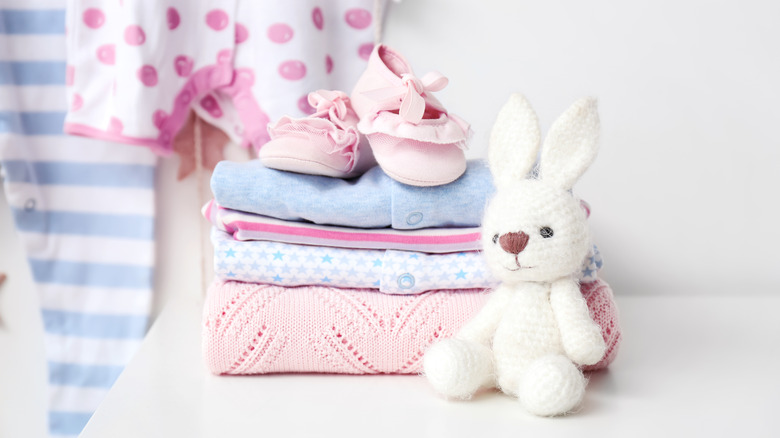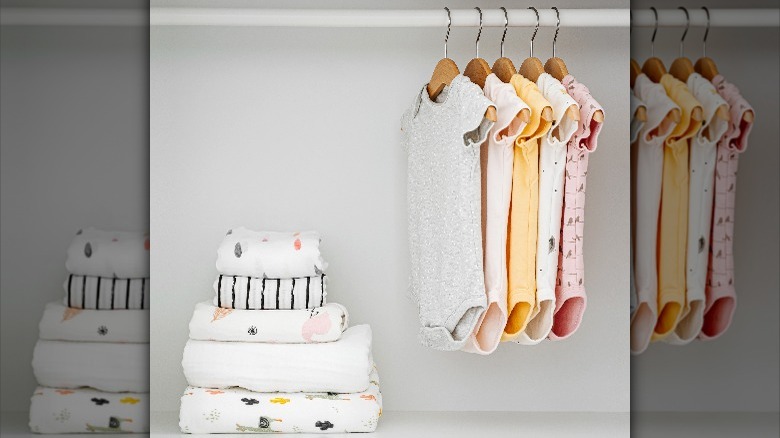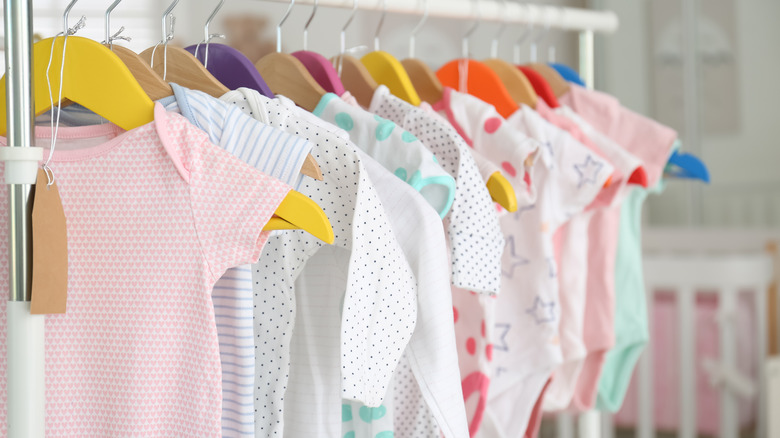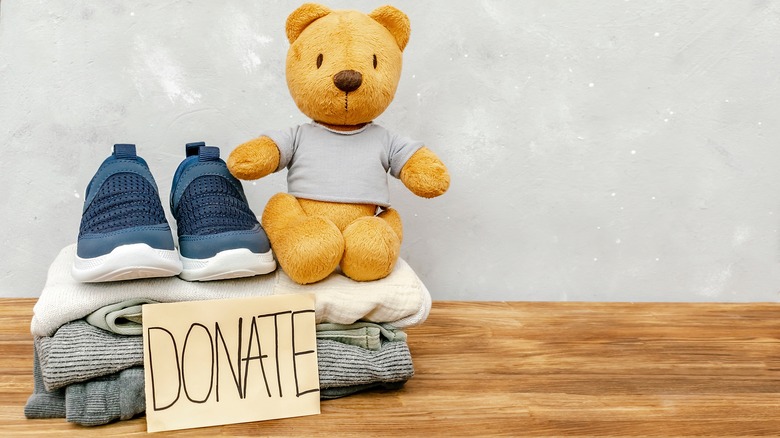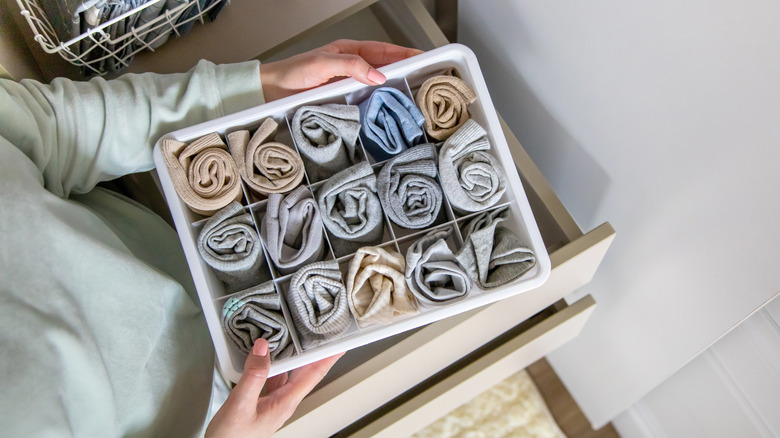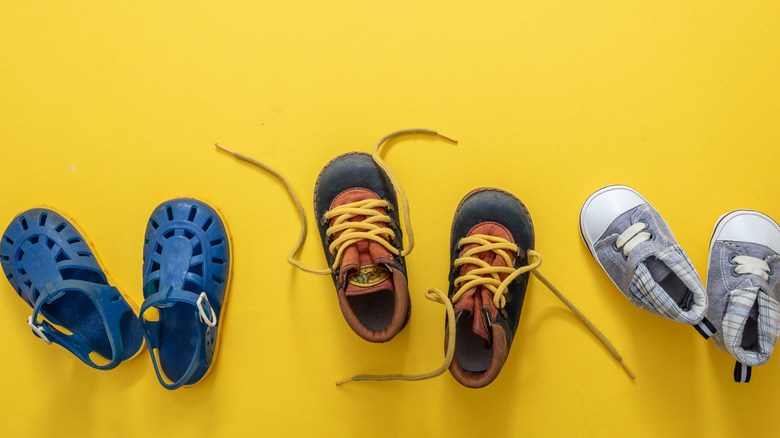5 Expert Tips For Organizing Your Baby's Clothes
If you think keeping your own clothes organized is difficult, keeping your baby's clothes in order may feel impossible. This is because, of course, baby clothes are much smaller and easier to misplace (especially their tiny socks). Additionally, oftentimes new parents receive or purchase an extensive amount of clothes, and trying to keep the large collection orderly may prove challenging. Further, because babies are constantly growing, they need lots of clothes in different sizes, which could make organization confusing. You may also be working with a limited amount of storage space.
However, it's important to keep your child's clothes arranged well for a number of reasons. Fibre 2 Fashion says that creating a system that works for you will make everything easily accessible, save you time when dressing your baby, and help you maintain an overall orderly household. If you're struggling to keep your baby's clothes in order, below are five organizational tips.
Choose what to hang and what to fold
When organizing your baby's clothes, the first thing to consider is which items you should hang and which ones should be folded and placed in a drawer. According to Making Of Mom, when deciding this, think about whether you most enjoy (or, perhaps, least dread) hanging or folding clothes. If you hate hanging, you should fold, and vice versa. Another important consideration is your nursery setup. If you don't have much closet space, you'll need to fold more clothes, and if you don't have room for a large dresser, you'll need to hang them.
Natural Baby Life recommends hanging certain items and folding others. For instance, they say that tops like shirts, jackets, sweaters, and sweatshirts are easy to hang. Additionally, hanging up dresses, bodysuits, and rompers will keep them from getting wrinkled. Further, it's a good idea to fold pajamas, pants, shorts, and onesies, as all these items are easier to tuck away in a drawer. You'll also most likely keep socks, headbands, and other smaller items in a dresser or in bins.
Include multiple rods
If you decide to hang most of your baby's clothes in the closet, it may be a good idea to add multiple clothes rods. This will allow you to use more vertical space since baby clothes are much smaller than adult clothes. Additionally, this can be a great space-saving solution for those who don't have much space in their dresser — and, it can free up room for items that have to be folded and tucked away (like burp cloths and bedding), per The Organized Mom.
A Girl's Guide To Home DIY recommends choosing an extendable closet rod with screws. You could also choose one that stays in place with the use of tension but keep in mind that these rods don't hold as much weight and may fall more easily. When installing the rod, make sure it's at a height and depth that allows for your baby's hangers to fit inside the closet.
Remove clothes that no longer fit
New parents may feel like they need an excess of clothes for their child. However, this can create chaos and may make you feel overwhelmed. Instead, it's best to remove clothes that no longer fit from your closet or dresser to make your space feel more organized. The Organized Mom recommends keeping each size of clothes in a different bin, which can be switched out as your child grows. This will keep you from having lots of different sizes of clothing all jumbled together. When using this method, make sure you label the bins.
Further, The Simply Organized Home says that you should go through your child's clothes often and remove anything that doesn't fit, isn't being used, or is too worn. Then, you can either donate or put clothes into storage to free up space. If you struggle to give away your baby's clothes, create a "maybe" bin and keep the clothes for about a month — if they aren't used during that time, you could decide to donate them. Additionally, when keeping clothes for future children, don't hold onto every piece. Learn what worked and what didn't from your first child (maybe certain pieces are uncomfortable or impractical) and only keep what worked well.
Use dresser bins or dividers
Because baby clothes are so tiny, they can easily become unfolded or mixed up when placed in dresser or wardrobe drawers. A great solution to this problem is using drawer bins or dividers. The Container Store sells lots of different organizers that can be used for a variety of items. For instance, those that are long and skinny are great for rolled-up onesies, while wide square bins would be great for items like balled-up socks. Think about what bins or dividers would make your baby's clothes more organized and easily accessible.
If you don't want to spend money on dividers, The Homes I Have Made demonstrates how to make them yourself. They use stiff cardboard and cover it with a shelf liner. To do this, cut two pieces of cardboard — one that extends the width of the drawer and one that extends the length. Then, cover them in shelf liner and cut slits in each piece. They can then be attached to one another and placed in the drawer to create four compartments.
Lay out shoes in pairs
Every piece of baby clothing is tiny and easy to lose, including their shoes. Throwing them all in a bin without any order could make dressing your baby difficult. Additionally, if you don't have an organized system, you may find yourself never using your baby's shoes at all.
Therefore, the way you organize your baby's shoes is important. Babe Basics says that, if you want to keep your child's shoes in a bin or basket, make sure to keep the pairs clipped together with clothespins. Another great way to store shoes is by keeping them in drawer dividers. Or, if you have unused shelves in the closet, you could keep the shoes in clear bins. The DIY Playbook found that the best method was to place their child's shoes inside a dresser drawer in pairs. This made them easily accessible and minimized the number of times they forgot to put on their baby's shoes before running out the door.
